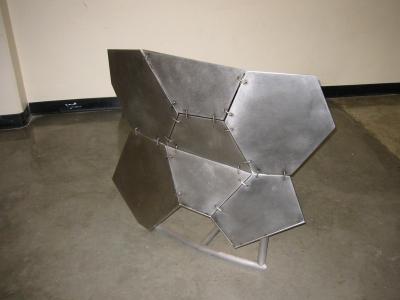July 10, 2003
Search for sculpture ends with charming find in ‘back yard’
The UW has commissioned a major sculptural work for the area north of Parrington Hall.
“The UW Public Art Commission has been looking for several years for a monumental sculpture, on the scale of Martin Puryear’s ‘Everything that Rises,’ located near Physics/Astronomy,” says Kurt Kiefer, campus art administrator. “We wanted something that pushed the boundaries and didn’t repeat existing form and techniques.”
The search was complicated by the fact that few sculptors working now create art that is generically designed for public spaces. Rather, they create “public art” that is specific to the site.
“It turns out that what made the most sense was someone right in our back yard,” Kiefer says. So, the Washington State Arts Commission/UW Public Art Commission has commissioned Cris Bruch, a well-known local artist, to create a sculpture for the space.
Kiefer describes the work as “anthropomorphic.” It will be roughly 20 feet long, 9 feet tall and 9 feet wide and will be made of stainless steel that has been dulled. It will be located at the north end of the Parrington Lawn. The location was approved by the Campus Landscape Advisory Committee earlier this year.
Kiefer says the sculpture “looks as if it was made of paper. It’s a charming, beautiful idea. It doesn’t refer to anything specifically in the immediate surroundings, although the metal references the steam plant, the Observatory and Meany Hall.
The model is only a suggestion of the sculpture’s final appearance. “We’ve given the artist the freedom to work creatively and reactively,” Kiefer says. “We hope that Bruch will put all his spirit and energy into the fine details that can only be resolved during the process of fabrication.”
Bruch is known for devising intricate systems, assembling small objects into much larger objects. Bruch’s current plan is to build a stainless steel structure to outline the basic shape of the artwork, then cover that structure with a tile-like skin of irregular hexagons of stainless steel.
“This system will allow him to control the basic form and mass of the object, while at the same time giving him the ability to improvise and rapidly change the piece as he goes along,” Kiefer says.
The work is expected to be completed this winter and installed in early spring. The project costs $200,000. Funding comes from the UW’s pooled “half-percent-for-art” funds generated by new campus construction. The Washington State Arts Commission/UW Public Art Commission is a standing body jointly appointed by the UW and the Washington State Arts Commission.




